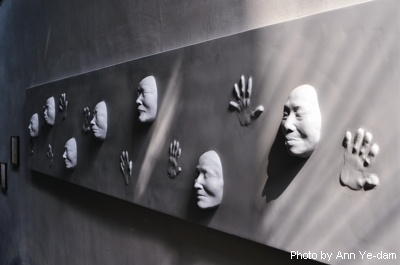
Though the path was full of obstacles, Yoon Mi-hyang, a Ewha alumni, was determined to continue on with this fight in order to fulfill the wish of a comfort woman who once said, “After observing and learning our history of comfort women, I plead the world to be a place without war and violence.”
“We aimed to fulfill the comfort women’s dearest wish to create a world without war and sexual violence, a world where the powerful do not oppress the weak,” Yoon said. “The museum will be a historical and educational ground on the importance of peace and human rights.”
The museum consists of one underground floor and two more stories rising above it. The overall flow of the museum progresses as a narrative museum, where the orientation of the exhibits goes through recollection, reflection, recovery and record.
The underground floor is where the “Room of Reverberation” is located, in which pictures, video clips, and painful voices of comfort women can be heard. A display on sexual slavery in Africa and Asia is organized on the first floor, along with the Special Exhibition Hall.
On the second floor, objects related to the issue of comfort women are put on view, reflecting on the history of the comfort women and the Wednesday Protest, which is a weekly demonstration led by the comfort women and their supporters in the pursuit of justice from the Japanese government. A few significant displayed artifacts include the bag comfort women took to the United Nations to raise awareness on their issue and the hand microphone that was used during the early Wednesday Protests.
Though it now stands as a record of the hardships and memories of comfort women, it took nine troublesome years to come this far and finalize the museum. The museum’s first kick-off was on December 2003 when 17 comfort women inaugurated a museum construction committee. Then in 2009, the museum started its construction at the Independence Park located in Seodaemun-gu, which was donated by the Seoul City.
However, the Korean Liberation Association opposed to the construction of the museum within the Independence Park, stating that it would be defamation for the patriotic martyrs of the country. As a result, the museum relocated to its current location at the end of Sungmi-san in Sungsan-dong.
This was not the only obstacle standing in front of them: Businesses were reluctant to sponsor the construction of the museum, saying it did not suit the corporate image.
“Businesses still hold taboo on comfort women, and this elongated the construction process,” Yoon said. “The will of the comfort women to record their tragic history and never allow history to repeat itself allowed for the museum to bloom.”
The first English tour of the museum will be held at 12:30 p.m. on May 19. Anyone interested should be at exit 2 of Hongdae Station and a guide will lead guests to the museum from there.
* Alumnae
Ko Min-seok
minseok_ko@ewhain.net

